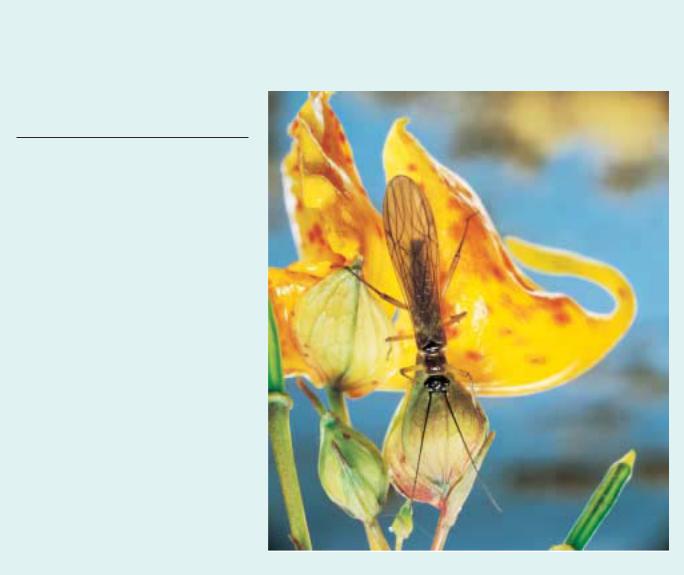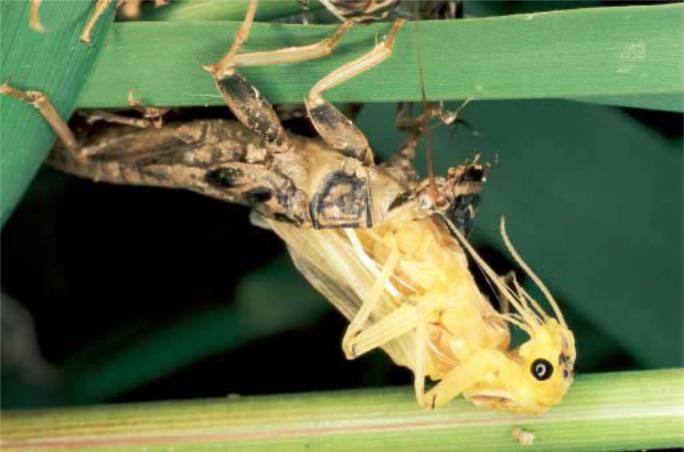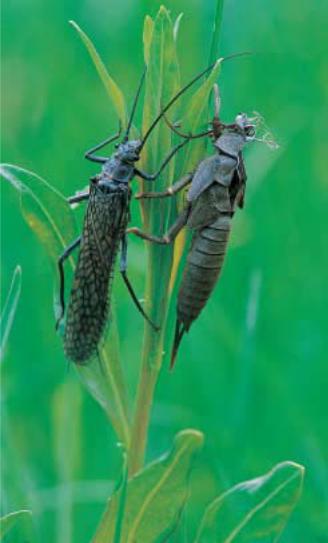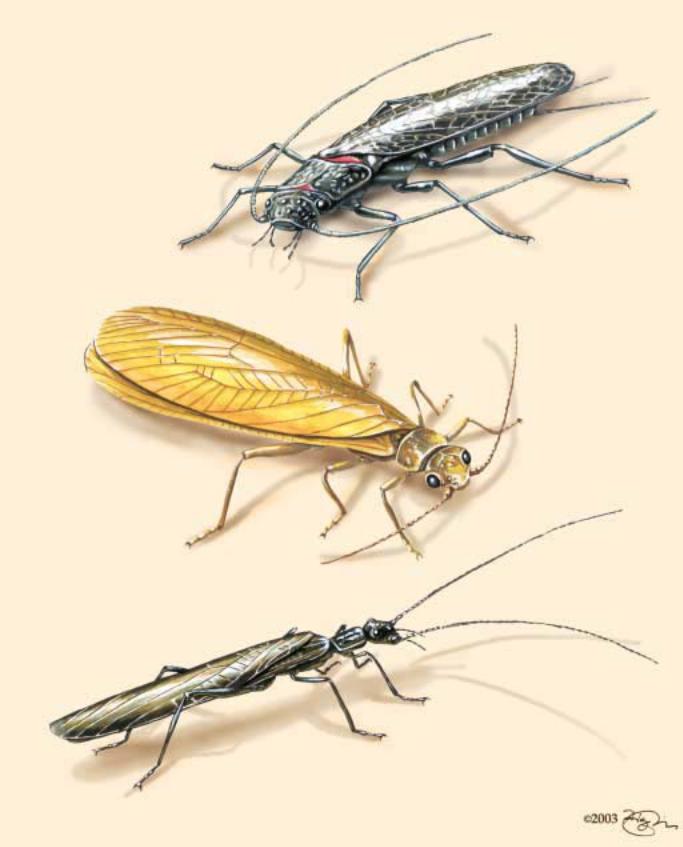
- •Contents
- •Foreword
- •How to use this book
- •Advisory boards
- •Contributing writers
- •Contributing illustrators
- •What is an insect?
- •Evolution and systematics
- •Structure and function
- •Life history and reproduction
- •Ecology
- •Distribution and biogeography
- •Behavior
- •Social insects
- •Insects and humans
- •Conservation
- •Protura
- •Species accounts
- •Collembola
- •Species accounts
- •Diplura
- •Species accounts
- •Microcoryphia
- •Species accounts
- •Thysanura
- •Species accounts
- •Ephemeroptera
- •Species accounts
- •Odonata
- •Species accounts
- •Plecoptera
- •Species accounts
- •Blattodea
- •Species accounts
- •Isoptera
- •Species accounts
- •Mantodea
- •Species accounts
- •Grylloblattodea
- •Species accounts
- •Dermaptera
- •Species accounts
- •Orthoptera
- •Species accounts
- •Mantophasmatodea
- •Phasmida
- •Species accounts
- •Embioptera
- •Species accounts
- •Zoraptera
- •Species accounts
- •Psocoptera
- •Species accounts
- •Phthiraptera
- •Species accounts
- •Hemiptera
- •Species accounts
- •Thysanoptera
- •Species accounts
- •Megaloptera
- •Species accounts
- •Raphidioptera
- •Species accounts
- •Neuroptera
- •Species accounts
- •Coleoptera
- •Species accounts
- •Strepsiptera
- •Species accounts
- •Mecoptera
- •Species accounts
- •Siphonaptera
- •Species accounts
- •Diptera
- •Species accounts
- •Trichoptera
- •Species accounts
- •Lepidoptera
- •Species accounts
- •Hymenoptera
- •Species accounts
- •For further reading
- •Organizations
- •Contributors to the first edition
- •Glossary
- •Insects family list
- •A brief geologic history of animal life
- •Index

●
Plecoptera
(Stoneflies)
Class Insecta
Order Plecoptera
Number of families 16
Photo: A stonefly (Leuctra fusca) on a balsam flower in Europe. (Photo by Kim Taylor. Bruce Coleman, Inc. Reproduced by permission.)
Evolution and systematics
Stonefly fossils date from the early Permian, about 258 to 263 million years ago. The fossil record of just under 200 species is most diverse in the Jurassic and is considered fragmentary in comparison with other aquatic insects, probably due to stoneflies’ preference for running waters that are not conducive to burial and fossilization. Stoneflies comprise a hemimetabolous (i.e., undergoing complete metamorphosis) order divided into two suborders: Arctoperlaria, containing 12 families (Capniidae, Chloroperlidae, Leuctridae, Nemouridae, Notonemouridae, Paltoperlidae, Perlidae, Pteronarcyidae, Scopuridae, Styloperlidae, and Taeniopterygidae); and Antarctoperlaria, containing four families (Austroperlidae, Diamphipnoidae, Eustheniidae, and Gripopterygidae). The order includes five superfamilies and more than 2,000 species.
Physical characteristics
Adult stoneflies vary in body length from about 0.19 to 1.97 in (5 to 50 mm) and in color from brown or black to green or yellow, usually marked with distinctive light or dark patterns.
They are typically winged, except, for example, a wingless aquatic adult of the family Capniidae known from the depths of Lake Tahoe, Nevada. Wings are typically fully winged (macropterous), but the wings of one or both sexes of some species or high altitude or latitude populations of a particular species are shortened (brachypterous) and are not functional. The ordinal name (Plecoptera = “folded wings”) describes the hind wings that typically have an expanded posterior lobe that folds under the main wing. Adults have 10 abdominal segments, a three-segmented tarsus, and a pair of terminal, usually multisegmented, cerci. The multisegmented larval cerci become reduced to fewer segments in some taxa and to a single segment in males of the families Leuctridae, Nemouridae, and some Taeniopterygidae. Males have distinctive genitalia consisting of various modifications of the ninth and tenth segments into paired hooks, lobes (paraprocts), sclerotized paired stylets, or a median terminal probe (epiproct). The aedeagus is housed inside the abdomen and extruded during copulation from behind the ninth sternum. The external female genitalia consists of a lobe-like plate usually on the eighth abdominal sternum covering the genital opening. Larvae may or may not
Grzimek’s Animal Life Encyclopedia |
141 |

Order: Plecoptera |
Vol. 3: Insects |
A stonefly (Leuctra fusca) nymph sheds its exoskeleton. (Photo by Roy Morsch. Bruce Coleman, Inc. Reproduced by permission.)
resemble their adult forms, and those of particular families or genera vary from being gill-less to having simple or branched gills, diagnostically located and structured, arising from parts of the body such as near mouthparts, thorax, coxae, or abdomen. Larvae always have a pair of multisegmented cerci, and the adults of gilled taxa usually retain stubs or vestiges of the larval gills that aid in their identification.
Adults occur in streamside microhabitats, including on or under rocks, moss, debris, leaf packs on the bank or projecting above the water surface, and in riparian vegetation. The larvae of a few species occur in wave-swept substrates of cold alpine or boreal lakes or in intermittent streams.
Distribution
This order is distributed worldwide, on all continents except Antarctica, and on most major islands except Cuba, Fiji, Hawaii, and New Caledonia. Species of the suborder Arctoperlaria are generally distributed in the Northern Hemisphere; exceptions are the family Notonemouridae, which occurs only in southern South America, southern Africa, Madagascar, Australia, Tasmania, and New Zealand, and the two genera of the family Perlidae, Anarcroneuria and Neoperla, that have moved south across the Equator in recent times. The suborder Antarctoperlaria is restricted to the Southern Hemisphere.
Behavior
The typical mating system of Northern Hemisphere stoneflies involves aggregation of males and females at encounter sites near streams, and vibrational communication for mate finding. Males call for females with species-specific drumming signals while performing a ranging search, and receptive stationary females answer with a simple drumming signal. These signals and the accompanying positioning allow males to minimize their search and triangulate on a particular female. Copulation occurs immediately after location with no specialized display. Males are polygamous, but females mate only once and then will no longer answer male drumming calls.
Habitat
Stoneflies are almost exclusively inhabitants of streams, where their larvae inhabit organic or mineral substrates.
Feeding ecology and diet
Stonefly adults of particular taxa are either nonfeeders (e.g., members of the group Systellognatha of Arctoperlaria) or are mainly herbivorous, feeding on pollen, nectar, or other
142 |
Grzimek’s Animal Life Encyclopedia |

Vol. 3: Insects
plant parts (e.g., some species of the group Euholognatha of Arctoperlaria). Larvae are either primarily herbivoredetritivores, insectivores, or omnivores, and in some cases their diet shifts among these categories as they develop through 10 to 25 instars. Herbivore-detrivores have molariform mandibles and are either scrapers, grazers, collectorgatherers, shredders, or gougers. Predators have sharp-cusped mandibles and toothed laciniae for grasping and holding their prey, which they actively seek in the interspaces of their leafpack or on mineral substrates in streams.
Reproductive biology
The mating of stoneflies involves a male mounting a female, curving his abdomen around her left or right side, engaging and pulling down the subgenital plate with his external genitalia, and typically inserting his aedeagus into her bursa. Sperm is therefore typically conveyed into the female by the intromittent aedeagus, but in some species sperm is deposited in a pocket beneath the subgenital plate and then aspirated internally by the female, while in other species sperm is conveyed through a hollow male epiproct. Eggs vary considerably in size, shape, and chorionic (egg shell) ornamentation and sculpturing. Penetration by sperm through a micropyle and fertilization, as in most insects, is delayed until just before oviposition (laying of eggs). Eggs are deposited in pellets or masses and released in one of two ways: 1) directly into water by the female splashing into the surface or dropping eggs from the air during an oviposition flight; or 2) being washed off in shallow water. Eggs may hatch within three to four weeks or enter a diapause (a period of arrested development) lasting from three months to one or more years. Generation time for larvae varies from four months to three or four years, depending on the taxa and on environmental conditions. The short-lived adults provide no parental care.
Conservation status
Stoneflies generally require unpolluted streams for continued population health and are therefore important biological indicators of stream water quality. They are important components of one of the major biomonitoring measures, the EPT (Ephemeroptera-Plecoptera-Trichoptera) Index. Some species are endemic to particular stream watersheds or rare and restricted in distribution to small geographic regions, and are therefore listed on various regional or national endangered species lists. Stonefly larvae can generally be thought of as similar in relative size, space requirements, and clean water physical and chemical tolerance to trout and other fish juveniles. Management practices of stream fisheries are therefore conducive also to stonefly management, although habitat or species management practices specifically for stoneflies have rarely been proposed or practiced.
Order: Plecoptera
A giant stonefly (Pteronarcys sp.) completing metamorphosis. (Photo by Joe McDonald. Bruce Coleman, Inc. Reproduced by permission.)
The 2002 IUCN Red List includes four stonefly species.
Alloperla roberti is categorized as Extinct; Leptoperla cacuminis and Riekoperla darlingtoni as Vulnerable; and Eusthenia nothofagi as Data Deficient.
Significance to humans
Stoneflies are entirely beneficial to humans as integral and important components of stream food webs and biological indicators of good water quality. Most adults have vestigial mouthparts and cannot bite. Their importance as fish food makes them, along with mayflies, caddisflies, and midges, of much interest to fly fishermen.
Grzimek’s Animal Life Encyclopedia |
143 |

1
2
3
1. Giant salmonfly (Pteronarcys californica); 2. Golden stone (Hesperoperla pacifica); 3. Common needlefly (Zealeuctra claasseni). (Illustration by Jonathan Higgins)
144 |
Grzimek’s Animal Life Encyclopedia |
